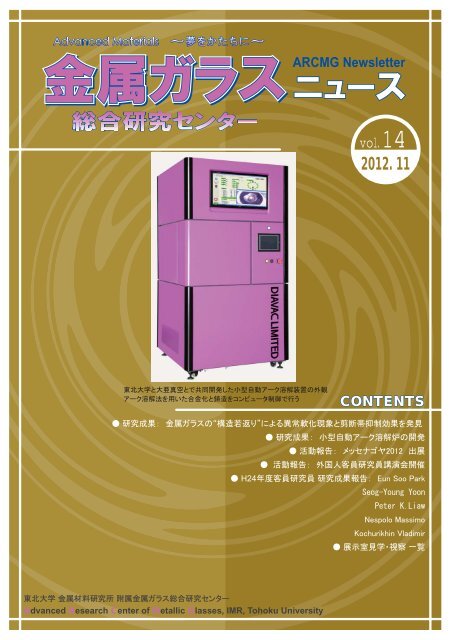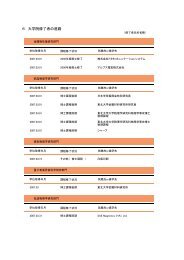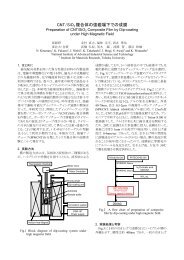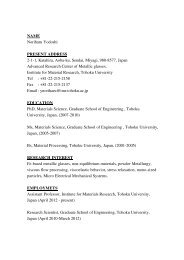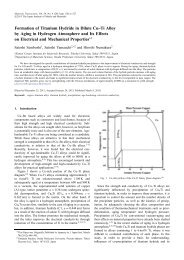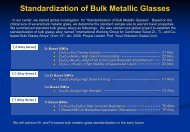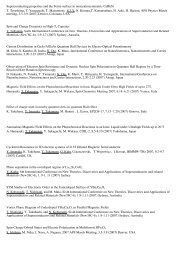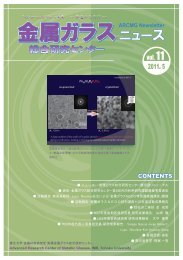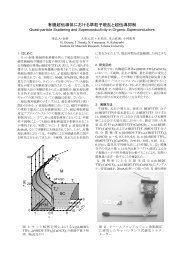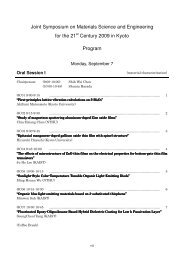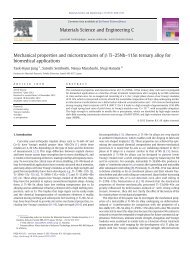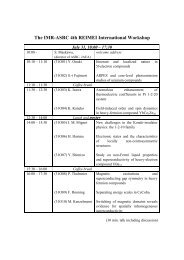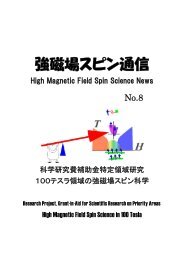ARCMG Newsletter - éå±ã¬ã©ã¹ - æ±å大å¦
ARCMG Newsletter - éå±ã¬ã©ã¹ - æ±å大å¦
ARCMG Newsletter - éå±ã¬ã©ã¹ - æ±å大å¦
You also want an ePaper? Increase the reach of your titles
YUMPU automatically turns print PDFs into web optimized ePapers that Google loves.
金 属 ガラス<br />
総 合 研 究 センター<br />
<strong>ARCMG</strong> <strong>Newsletter</strong><br />
ニュース<br />
vol. 14<br />
2012. 11<br />
東 北 大 学 と 大 亜 真 空 とで 共 同 開 発 した 小 型 自 動 アーク 溶 解 装 置 の 外 観<br />
アーク 溶 解 法 を 用 いた 合 金 化 と 鋳 造 をコンピュータ 制 御 で 行 う<br />
CONTENTS<br />
● 研 究 成 果 : 金 属 ガラスの“ 構 造 若 返 り”による 異 常 軟 化 現 象 と 剪 断 帯 抑 制 効 果 を 発 見<br />
● 研 究 成 果 : 小 型 自 動 アーク 溶 解 炉 の 開 発<br />
● 活 動 報 告 : メッセナゴヤ2012 出 展<br />
● 活 動 報 告 : 外 国 人 客 員 研 究 員 講 演 会 開 催<br />
● H24 年 度 客 員 研 究 員 研 究 成 果 報 告 : Eun Soo Park<br />
Seog-Young Yoon<br />
Peter K.Liaw<br />
Nespolo Massimo<br />
Kochurikhin Vladimir<br />
● 展 示 室 見 学 ・ 視 察 一 覧<br />
東 北 大 学 金 属 材 料 研 究 所 附 属 金 属 ガラス 総 合 研 究 センター<br />
Advanced Research Center of Metallic Glasses, IMR, Tohoku University
金 属 ガラス 総 合 研 究 センターニュース Vol. 14<br />
研 究 成 果<br />
金 属 ガラスの“ 構 造 若 返 り”による 異 常 軟 化 現 象 と 剪 断 帯 抑 制 効 果 を 発 見<br />
“ 構 造 若 返 り” の 利 用 で 金 属 ガラスに<br />
常 温 加 工 の 可 能 性 を 示 唆<br />
金 属 ガラス 総 合 研 究 センター 前 期 客 員 教 授 土 谷 浩 一 教 授 ( 独 立 行 政 法 人 物 質 ・ 材 料 研 究 機 構 構 造 材 料 ユニット 副 ユニッ<br />
ト 長 )らは、 当 センターとの<br />
共 同 研 究 により、 金 属 ガラスに 5 GPa の 高 圧 下 で 巨 大 な 剪 断 ひずみを 付 与 する 事 で、 硬 度 や<br />
弾 性 率 が 顕 著 に 減 少 する 異 常 軟 化 現 象 を 発 見 しました。 。この 異 常 軟 化 に 伴 い 金 属 ガラスを ガ 常 温 で 変 形 したときに 不 均 変 形<br />
をもたらす 剪 断 帯 の 発 生 が 抑 制 され、 均 一 変 形 していることを 明 らかにしました。<br />
本 研 究 成 果 は2012 年 9 月 24<br />
日 発 行 のApplied Physics Letterに 掲 載 されました。<br />
( 文 責 : 横 山 嘉 彦 )<br />
加 工 前<br />
10 回 転 加 工<br />
剪 断 帯<br />
500 回 転 加 工<br />
50 回 転 加 工 後 熱 処 理<br />
ナノインデンテーション 圧 痕 の 走 査 プロー ーブ 顕 微 鏡 像 の HPT 加 工 と 熱 処 理 (400℃,1 時 間 )による 変 化<br />
50<br />
小 型 自 動 アーク<br />
溶 解 炉 の 開 発<br />
アーク 溶 解 法 を 自 動 化 にするために 必 要 な 自 動 反 転 技 術 、 溶 湯 攪 拌 技 術 について、<br />
大 亜 真 空 株 式 会 社 と 共 同 開 発 し、 同 社 から「 小 型 自 動 アーク 溶 解 炉 」として 発 売 さ<br />
れます( 図 1 参 照 )。 共 同 開 発 した 複 数 の 新 技 術 について、 東 北 大 学 と 大 亜 真 空 株<br />
式 会 社 との 共 同 出 願 で 特 許 を 申 請 しております。<br />
本 小 型 自 動 アーク 溶 解 炉 を 用 いることで、 合 金 や 鋳 造 製 品 ( 単 純 形 状 に 限 る)のの<br />
量 産 化 は 可 能 になり 産 業 貢 献 が 期 待 できますが、 研 究 にとっても 利 点 が 期 待 できまま<br />
す。 本 開 発 装 置 は、その全 ての 動 作 をコンピュー<br />
ター(LabVIEW: National<br />
Instruments Co.)で 制 御 しているため、 インターネットに 接 続 をすることで 世 界<br />
中 のどこからでも 本 装 置 を 操 作 することが<br />
可 能 になります。 一 方 、 金 属 材 料 研 究 所<br />
は、 全 国 共 同 利 用 に 取 り 組 んでおりますが、 共 同 利 用 研 究 者 の 中 には<br />
思 うように 試<br />
料 作 製 が 行 えず<br />
訪 問 期 間 のほとんどを 試 料 作 製 に 費 やすケースが 見 られました。 本<br />
開 発 装 置 を 用 いることで、 金 属 ガラス 総 合 研 究 センター ーで 行 っている<br />
全 国 共 同 利 用<br />
の 他 大 学 の 先 生 が、 本 所 訪 問 の 前 に、 試 料 作 製 を 予 備 的 に 遠 隔 操 作 で 実 験 することと<br />
で 効 果 的 な 共 同 研 究 の 推 進 をすることが 可 能 になるものと 期 待 しております。<br />
( 文 責 : 横 山 嘉 彦 )<br />
図 1 開 発 装 置 の 外 観
金 属 ガラス 総 合 研 究 センターニュース Vol. 14<br />
活 動 報 告<br />
メッセナゴヤ2012 出 展<br />
11 月 7 日 ( 水 )から10 日 ( 土 )まで、 名 古 屋 市 ポートメッセなごやに 於 いて~ 環 境 ・ 安<br />
全 ・モノづくり~をテーマに<br />
開 催 された 日 本 最 大 級 異 業 種 交 流 展 示 会 “メッセナゴヤ2012”<br />
に 当 センターが<br />
出 展 をいたしました。<br />
今 回 は 東 日 本 復 興 支 援 コー ーナーを 含 み、<br />
過 去 最 大 の650 社 が 出 展 をする 中 、 当 センター セ<br />
も 金 属 ガラスのボタン 試 料 ・バルク 試 料 や 実 用 製 品 の 展 示 を 行 い、 多 くのお 客 様 にお に 立 ち<br />
寄 りいただき 研 究 成 果 をご 紹 介 することが<br />
出 来 ました。<br />
( 文 責 : 湯 葢 邦 夫 )<br />
金 属 ガラス 総 合 研 究 センター 外 国 人 客 員 研 究 員 講 演 会 開 催<br />
本 年 度 、 当 センター 招 へい 外 国 人 客 員 研 究 員 のうち、3 名 の 先 生 方 による 講 演 会 を 以 下 の 内 容 で 実 施 いたしました。<br />
それぞれ 多 くの 研 究 者 および 学 生 が 聴 講 し、 大 変 盛 況 でした。 特 に、ロレーヌ 大 学 のMassimo 先 生 の 講 演 には<br />
多 元 研 から、<br />
ソウル 大 学 の 朴 先 生 の 講 演 にはNIMSから、Peter 先 生 の 講 演 にはWPIから、といった 具 合 に、 他 部 局 や 他 大 学 から<br />
も 多 数 のご 参 加 をいただきました。<br />
○フランス ロレーヌ 大 学 教 授 Nespolo Massimo 先 生<br />
「Challenges<br />
beyond conventional crystallography in<br />
theconventionalspace」6<br />
月 20 日 開 催 ( 於 : 本 多 記 念 館 3F 聴 覚 室 )<br />
○ 韓 国 ソウル 大 学 助 教 朴 殷 洙 先 生<br />
「Property Manipulation of Metallic Glassesby Secondary Amorphous<br />
Phases」7 月 18 日 開 催 ( 於 : 本 多 記 念 館 3F 視 聴 覚 室 )<br />
○ 米 国 テネシー 大 学 教 授 Peter K. . Liaw 先 生<br />
「Fatigue Behaivior of Metallic Glasses」7 月 31 日 開 催<br />
( 於 : 旧 COE 棟 セミナー 室 1)<br />
( 文 責 : 横 山 嘉 彦 )<br />
講 演 者 からの 質 問 に 答 える Peter 先 生<br />
Nespoloo Massimo 先 生 講 演 風 景<br />
朴 先 生 を 囲 んでで 記 念 撮 影<br />
H24 年 度 外 国 人 客 員 研 究 員 研 究 成 果 報 告<br />
Formation and<br />
Mechanical Properties of Zr-based Bulk Metallic Glass Composites<br />
with In-situ Formed ZrN Particles<br />
Prof. . Eun Soo Park<br />
Research Institute of<br />
Advancedd Materials, , Department of Materials Science and Engineering,<br />
Seoul Nationall University, Seoul 151-744, Republic of Korea<br />
From 28 th of June to 10 th of August 2012, I was a visiting<br />
professor in the Advanced Research Center of Metallic<br />
Glass at the Institute of Materials Research, Tohoku<br />
University,<br />
working with Associate Professor Yoshihiko<br />
Yokoyama. I had<br />
a prior experience of staying at the<br />
National Institute for Materials Science (NIMS) in Japan<br />
for three months<br />
during early 2003. However, this visit<br />
was the first experience to stay<br />
at IMR and<br />
in<br />
the Sendai area.<br />
During this visit, I focused my research on<br />
development<br />
of novel Zr-based Z bulk<br />
metallic<br />
glass<br />
composites<br />
with in-situ formed ZrN<br />
particles. Thee research was<br />
performed<br />
byy using the<br />
advanced apparatus of IMR<br />
and<br />
WPI of Tohoku<br />
University.<br />
Bulk<br />
metallic<br />
glasses<br />
(BMGs)<br />
havee begun to
金 属 ガラス 総 合 研 究 センターニュース Vol. 14<br />
attract increasing attention because they have many<br />
interesting characteristics such as high mechanical<br />
strength and corrosion resistance that aree different from<br />
those of crystalline alloys due to the non-periodicity<br />
of<br />
their<br />
atomic arrangement. However, sincee the initiation<br />
and propagation<br />
of shear bands take place almost<br />
simultaneously,<br />
monolithic BMGs exhibit only limited<br />
plasticity due to the formation of highly localized shear<br />
bands under loading. The extent of the plastic deformation<br />
in the BMGs depends on the total amount of shear bands<br />
generated during<br />
deformation. Therefore, plasticity of the<br />
BMGs could be improved by generating a large number of<br />
shear bands and impeding their sudden propagation. Thus,<br />
the concept of constructing<br />
a heterogeneous<br />
microstructure by<br />
introducing<br />
secondary phases withinn a<br />
glassy matrix was adopted to improve plasticity of the<br />
BMGs. The in-situ formation of reinforcement during<br />
preparation of the composite<br />
has been thought to be<br />
effective for good wettability<br />
between dispersoids and<br />
matrix as well as homogenous<br />
dispersion of<br />
reinforcements. In this study, Zr-Al-Ni-Cu<br />
BMG matrix<br />
composites containing nitride ceramic particles were<br />
prepared by introducing particulate Al/AlN<br />
composites as<br />
starting materials. The microstructure of f the composite<br />
reinforced with ZrN particles and their mechanical<br />
properties were investigated.<br />
A Zr-Ni-Cu pre-alloy ingot was prepared by arc-melting<br />
pure<br />
metals in a Ti-gettered argon (99.999%) atmosphere.<br />
Subsequently, a mixture of the pre-alloyed ingot and<br />
Al/AlN composites (37 % volume fraction<br />
of AlN) was<br />
re-melted in the arc-melting furnace. BMG matrix<br />
composites with the matrix composition of Zr55Al10Ni5Cu<br />
u30,<br />
which is a well-known Rapidly<br />
solidified specimens were prepared by<br />
re-melting the composite alloys in quartz tubes and<br />
ejecting with an over-pressuree of 50 KPa through a nozzle<br />
onto a Cu wheel rotating with a surface velocity of 40 m/s.<br />
high glass forming alloy, were<br />
prepared.<br />
Cylindrical samples of 1-3 mmm in diameterr and 50mm in<br />
length were obtained by suction casting in a water cooled<br />
copper mold. The<br />
morphology<br />
and microstructure of the<br />
in-situ synthesized Zr BMG/ZrN compositee were observed<br />
by scanning microscopy (SEM; JSM6360, JEOL). Phase<br />
composition of the composite was characterized by X-ray<br />
diffraction analysis (XRD; New<br />
D8 advance, Bruker) using<br />
monochromatic Cu Kα radiation for a 2θ range of 20-800 o .<br />
The elastic modulus was obtained from ultrasonic<br />
measurement and<br />
the density of<br />
the compositee was determined<br />
using<br />
the Archimedes’ method.<br />
Fig. 1 shows the<br />
XRD resultss of the as-spun ribbons and<br />
the master alloy.<br />
The mass fraction of the starting AlN<br />
particles in the composite was 1.7 wt. %. It was found that<br />
the pattern of the<br />
composite ribbon sampless was composed<br />
of a halo pattern<br />
and diffraction peaks, indicating the<br />
coexistence of glassy and crystalline phases. It should be<br />
noted that the diffraction peaks are not assigned to the<br />
AlN phase but to the ZrN phase in both<br />
of composite<br />
ribbon and master alloy sample. These results r indicate<br />
that chemical reaction(Zr + AlN → Al + ZrN) occurred<br />
during the arc melting.<br />
Fig. 1 XRD patterns for (a) Zr55Al10Ni5Cu30 ribbon; (b) Zr<br />
BMG/ZrN composite ribbon; ; (c) Zr BMG/ ZrN composite<br />
masterr alloys<br />
Fig. 2 shows a SEM imagee of cross-section of as-cast<br />
composite containing 4 vol.% ZrN. The ZrN<br />
particles under<br />
10 μm sizes are homogeneoush<br />
sly dispersed in BMG matrix.<br />
EDS analysis revealed that the bright spherical particles<br />
were ZrN and the grey massive domain surrounding s<br />
the<br />
ZrN<br />
particles were Zr-Al-Ni-Cu metallic glass.<br />
Fig. 2 SEM micrograph of in-situ formed ZrN reinforced<br />
Zr-based BMG composite<br />
Fig. 3 shows mechanical properties of as-cast monolithic<br />
BMGs and composite<br />
with 1 mm diameter. The<br />
compression fracture strength of the Zr BMG/ZrN<br />
composite was about a 2.1 GPa, being higher than thatt of<br />
the Zr BMG (about 1.7 GPa). . It is also worth noting that<br />
the BMG composite showed improved plasticity before its<br />
fracture. In addition, a slightly serrated plastic flow was<br />
also<br />
observed inn the plasticc deformation<br />
region of the<br />
stress–strain curve. These results suggest that multiple<br />
shear bands were formed during plastic deformation.<br />
These improved mechanical properties attributed to the<br />
fine,homogeneously dispersedd ZrN particles in the BGM<br />
matrixeously dispersed ZrN particles in the BMG matrix.
金 属 ガラス 総 合 研 究 センターニュース Vol. 14<br />
Fig.3<br />
Compressive stress-strain curve at a strain s rate 1.00 x<br />
10 -4 /s: (a) Zr BMG; (b) Zr BMG/ZrN composite (4 vol. .%<br />
ZrN)<br />
The Zr-based BMG matrix composites reinforced by the in<br />
situ produced ZrN particles were successfully fabricated<br />
by arc melting Zr-Ni-Cu pre-alloy and Al/AlN composite as<br />
starting materials. The ZrN<br />
particles off the order of<br />
micrometers in size considerably improve both the<br />
compressive strength and plasticity of the matrix. The<br />
compressive fracture strength increases from 1750 MPa in<br />
the ncluded that arc melting Zr-Ni-Cu pre-alloy and<br />
particulate Al/AlN<br />
composite as the starting materials is<br />
useful for preparing bulk, dispersed, crystalline nitride<br />
reinforced<br />
BMG<br />
compositess with good<br />
mechanical<br />
properties.<br />
explorations to synthesize novel in-situ bulk metallic glass<br />
express my composites by using the advanced apparatus<br />
in IMR and WPI. These materials have a great potential<br />
for advanced structural applications. I would like to<br />
express my sincere gratitude to Prof. Yoshihiko Yokoyama<br />
for the invitation to IMR of Tohoku University. I also<br />
extend many thanks to Ms. Yuka Chiba forr her many helps<br />
with<br />
the administrative paper work and very useful daily<br />
life advices.<br />
Thank you all again and “Sayonara Kinken”<br />
During about 40 days of collaboration with Prof. Yoshihiko<br />
Yokoyama and staff members, we have donee some valuable<br />
Evaluation of biphasic calcium<br />
phosphatee for application of biomaterials; physical, chemical<br />
property and in vitro<br />
behavior<br />
Prof. Seog-Youngg Yoon<br />
School of Materials Science & Engineering, Pusan National University, South Korea<br />
From 10 th of<br />
July to 24 th of August 2012, I workedd<br />
as a visiting professor in<br />
the Advanced Researchh<br />
Center of Metallic Glass at<br />
the Institutee of Materialss<br />
Research, Tohoku University<br />
working withh<br />
Associate Professor Hidemi Kato. I already had ann<br />
experience to<br />
stay at IMR<br />
for one month and half<br />
during early year of 2009.<br />
During this visit, I have been focusing<br />
my researchh<br />
on the evaluation of biphasic calcium<br />
phosphatess<br />
(consisted of<br />
hydroxyapatite and beta-tricalciumm<br />
phosphate) which are synthesized by aqueouss<br />
method. The evaluation was pointed out physical<br />
and chemical<br />
properties such as the crystallinity,<br />
chemical state, morphologies<br />
before and after in vitro<br />
experiment by using thee<br />
advanced apparatus of IMR and WPI of Tohokuu<br />
University.<br />
The most widely used calcium phosphate-basedd<br />
materials<br />
are<br />
hydroxyapatite<br />
[HAp,<br />
Ca10(PO4)6(OH<br />
H)2] and β-tricalcium phosphate [β-TCP,<br />
Ca3(PO4)2].<br />
Despite their<br />
favorable<br />
biological<br />
properties, both materials have a number of<br />
drawbacks that reduce their clinical performance. In<br />
vivo and in<br />
vitro dissolution experiments havee<br />
indicated that the dissolution of HAp in i the humann<br />
body after implantation is too low too achieve thee<br />
optimal formation of bone tissue. On the other hand,<br />
β-TCP shows fast release of Ca 2+ and PO4 3- ions whenn<br />
exposed to physiological fluids. The fast dissolutionn<br />
profile drastically reduces the surface area availablee<br />
for bone cell<br />
proliferation and therefore,<br />
itss<br />
application in<br />
the clinical setting iss limited. Ann<br />
optimum<br />
bioresorbability was found f whenn<br />
appropriately<br />
mixing both<br />
phases to give biphasicc<br />
calcium phosphates (BCPs).<br />
BCP<br />
powders<br />
were synthesized<br />
by thee<br />
co-precipitatio<br />
on method using reagent-grade calciumm<br />
nitrate<br />
tetrahydrate<br />
[Ca(NO3)2·4H2O] and<br />
di-ammonium<br />
hydrogen<br />
orthophosphate<br />
[(NH4)2HPO4]<br />
as the starting<br />
materials. Thee various input<br />
Ca/P molar ratios employed<br />
to<br />
prepare the different<br />
contents of HAp and β-TCP<br />
phases. Hanks’ balanced salt<br />
solution (HBSS),<br />
an<br />
extracellular<br />
solution with an ionic composition<br />
similar to human blood plasma, was used as the<br />
supporting solution for thee BCP powders in an in<br />
vitro test.<br />
XRD patterns of as-synthesized powders are<br />
presented<br />
in Fig. 1(a) ). The powders<br />
were<br />
characteristic of o crystalline HAp phase except e for the<br />
difference in peak p width and absolute intensity of<br />
the diffraction patterns. Fig. 1(b) shows details of the<br />
XRD patterns recorded r for the BCP powders calcined<br />
at<br />
900oC. Calcination off the powders at this<br />
temperature<br />
indicates the improvement<br />
in<br />
crystallinity by b the increase in the resolution r of<br />
peaks when compared to the as-synthesized powders.<br />
At this temperature, all thee powders have the β-TCP<br />
phase in addition to that of HAp phase thus<br />
confirming thee formation off biphasic mixtures.
金 属 ガラス 総 合 研 究 センターニュース Vol. 14<br />
Fig.1.<br />
XRD patterns of BCP powders; (a)<br />
as-synthesize<br />
d, (b) as-calcined.<br />
FTIR<br />
spectra for the as-synthesized<br />
powderss<br />
presented in Fig. 2(a) have<br />
indicated the vibrational<br />
modes of PO4 groups at 574, 603, and 1020-1120 cm - 1<br />
and OH groups (630 and 3570 cm -1 ) of apatite phasee<br />
for the powders. FTIR patterns also tend to coincidee<br />
with the results from XRD by the way that thee<br />
as-synthesize<br />
d powders were characteristic<br />
of<br />
crystalline HAp phase. The presencee of adsorbedd<br />
water could be detected from FTIR spectra in thee<br />
region around 3300-3600 cm -1 . Otherr informationn<br />
from FTIR spectra of as-synthesized<br />
powders iss<br />
presence of carbonates groups at 870 cm<br />
-1 , which aree<br />
due to the adsorption of species remaining from thee<br />
aqueous precipitation. The presence of o nitrates inn<br />
the as-synthesized powders is clearly witnessed inn<br />
the FTIR patterns in the region around at 825 andd<br />
1385 cm -1 . From the FTIR<br />
spectra presented in Fig.<br />
2(b), the overall spectra are appeared at havingg<br />
mainly two modes corresponding to characteristicc<br />
c<br />
PO4P<br />
3- and OH<br />
- groups.<br />
Fig.2. FT-IR spectra of BCP powders; (a) as-synthesized, (b)<br />
as-calcined.<br />
To determine the changes in the degradationn behavior of thee<br />
prepared BCP powders as a function of soaking time inn<br />
HBSS. Fig. 3 shows the typical features off powders after<br />
immersing in HBSS for 1, 2, and 3 weeks, respectively.<br />
After<br />
immersion in HBSS for 1 week, thee<br />
precipitation<br />
starts to be<br />
formed with individual<br />
small pieces on each BCP powders. With increase of<br />
soaking time, the pieces gradually grow<br />
together to<br />
form a densee layer on the overall BCP powderss<br />
surface. The EDS analysis showed thee new formedd<br />
precipitates had<br />
the Ca and P, indicating calcium deficient<br />
apatite phase.<br />
Fig.3. SEM morphologies of calcined BCP powders after<br />
immersion in HBSS for (a) 1, (b) 2, and (c) 3 weeks, (d) EDS<br />
f (c).<br />
Fig.4. Changes of o Ca 2+ and PO44 3- ions concentrations in<br />
HBSS immersedd with calcined BCP powder with 3 weeks.<br />
The ICP-AESS analysis reveals the changes of Ca 2+<br />
and PO4 3- concentrations inn HBSS after immersing<br />
the BCP powder, as shown in Fig. 4. The<br />
concentration<br />
of Ca 2+ and PO4 3- ions and in HBSS<br />
continually<br />
decreased d<br />
with<br />
immersing<br />
time,<br />
suggesting that the Ca 2+ and PO4 3- ions might be<br />
consumed by formation f of a new product. the Ca 2+<br />
and PO4 3- ions in HBSS were continuously consumed,<br />
which indicated that the Ca 2+ and PO44 3- ions were<br />
supersaturatedd around thee magnesiumm substituted<br />
BCP powder and a a new calcium deficient apatite<br />
phase continually grew on the sample surfaces with<br />
increase of immersing time.<br />
This study demonstrates that the co-precipitation<br />
method is an effective e technique for preparing BCPs<br />
whose content in β-TCP and HAp can be precisely<br />
determined from the precursor solutions. After<br />
immersion in HBSS H for 1 week, precipitation started<br />
at<br />
individual small particles on the BCP powders.<br />
With increases in the soaking time, the t particles<br />
gradually greww together andd formed a dense layer on<br />
the specimen surface. s Furthermore, BCP have been<br />
shown to be effective for<br />
new bonee generation<br />
implant materials.<br />
During the two months of f collaboration with Prof.<br />
H.Kato and staff s members, we have done some<br />
valuable explorations to synthesize some novel<br />
biomaterials by b using the e advanced apparatus in<br />
IMR and WPI. These materials have a great<br />
potential for medical m applications.<br />
I would like too express my sincere gratitude to Prof.<br />
H.Kato for the t invitation to IMR of Tohoku
金 属 ガラス 総 合 研 究 センターニュース Vol. 14<br />
University. I also extend many thanks to Ms.<br />
K.Sekiguchi<br />
for her many helpss with thee<br />
administrativ<br />
ve paper work<br />
and very useful daily lifee<br />
advices.<br />
Thank you all again and “Sayonara Kinken”<br />
CoCrCuFeNi High Entropy Alloys Subjected too Cyclic Loads<br />
Prof. Peter K Liaw<br />
Department of Materials Science and Engineering,<br />
Universityy of Tennessee, USA<br />
From 20 th of July to 24 th off<br />
August 2012, I worked as a<br />
visiting<br />
professor at thee<br />
Advanced Research Centerr<br />
of Metallic Glasses at thee<br />
Institute<br />
of Materialss<br />
Research, Tohoku Universityy<br />
working<br />
with<br />
Professorr<br />
Yoshihiko Yokoyama.<br />
During this visit, I havee<br />
been focusing my researchh<br />
on an Al0.5CoCrCuFeNi highh<br />
entropy alloy<br />
(HEA) to study its fatigue behaviorr<br />
with Prof. Yoshihiko Yokoyama. Moreover, a Weibull<br />
predictive model and a Weibull mixture predictivee<br />
model<br />
are conducted statistically to furtherr<br />
investigate the scatter fatigue characteristics withh<br />
Prof. T. Yuan of Ohio University, such as a noticeablee<br />
amount of scatter at various stress levels of HEAs.<br />
Recently,<br />
HEAs have<br />
attracted<br />
increasingg<br />
attentions because of their<br />
unique composition,<br />
phase structures, and good mechanical properties.<br />
They can be defined as solid-solution<br />
alloys thatt<br />
contain more than five principal elements in equal orr<br />
near equal atomic ratios and can bee extended too<br />
those compositions in which each principal elementt<br />
concentration<br />
n is between<br />
5 and 35 at.%. In thee<br />
as-rolled<br />
and as-anneal<br />
condition,<br />
thee<br />
Al0.5CoCrCuF<br />
FeNi HEA has a better combination of<br />
strength and ductility. The<br />
mechanicall properties of<br />
the as-cast AlxCoCrCuFeNi (x = 0 - 3) alloys providedd<br />
by Prof. Jien Wei Yeh of Nationall Tsing Huaa<br />
University are readily available. However,<br />
essentially no research has been performed onn<br />
studying the fatigue behavior of this and otherr<br />
promising HEA systems.<br />
The specimens of Al0.5CoCrCuFeNi<br />
(molar ratio)<br />
are prepared by arc melting the constituent elementss<br />
at a current of<br />
500 A in a water-cooled copper hearth.<br />
The compositions are all at least 99 wt. % pure. Thee<br />
cast samples are annealed<br />
at 1,000 o C for f 6 h, waterr<br />
quenched, and<br />
then cold rolled. The rolling reductionn<br />
is 84%, with a final thickness of 3 mm. . Samples aree<br />
machined to four-point-bending fatigue samples of<br />
25 × 3 × 3 mm parallel to the rolling direction. Too<br />
remove as many surface imperfectionss as possible,<br />
the samples are polished.<br />
Tension testss are initially<br />
performed on<br />
the sampless<br />
to characterize the mechanical property<br />
of the rolledd<br />
material. The<br />
results are<br />
shown in Figure 1. Thee<br />
specimens exhibit a high yield stress of 1,284 MPaa<br />
and an ultimate tensile strength of 1,344 MPa with a<br />
tensile elongation of 7.6%.<br />
Fig. 1 Tension testt flow curve for f the<br />
Al0.5CoCrCuFeNi HEA [1].<br />
The synchrotron X-ray diffraction (XRD) pattern of<br />
the Al0.5CoCrCuFeNi HEA, seen in<br />
Figure 2,<br />
indicates a face-centered-cubic (fcc) structure with<br />
the presence of an ordered Ll2 phase. Only one set of<br />
fcc peaks is seen s in the XRD pattern. Using the<br />
back-scatteredd<br />
electron microscopy (BSE) and<br />
energy-dispersive<br />
X-ray spectroscopy<br />
(EDS)<br />
techniques, the microstructure consists of two<br />
phases: the α-fcc matrix phase and the β-fcc Cu-rich<br />
phase.<br />
Four-point-be<br />
ending fatiguee tests are performed and<br />
the results are plotted as the stress range vs. the<br />
number of cycles to failure e or 10 7 cycles to give the<br />
stress vs. cycles to failure curve seen in Figure 3.<br />
There is a noticeable amount of scatter at various<br />
stress levels. At A a maximum stress of 1,250 MPa,<br />
most failures are a within a range of 35,000 – 450,000<br />
cycles. As the stress level decreased, the spread in<br />
the data become even more obvious. Based on the<br />
stress ranges, estimations of the endurance limits<br />
are within a lower bound of 540 MPa and an upper<br />
bound of 945 MPa. Valuess were chosen since the<br />
specimens reach 10 7 cycles without failure.<br />
Fig. 2 Diffraction patternn of the Al0.5CoCrCuFeNi<br />
HEA using synchrotron high energy X-rays [1].
金 属 ガラス 総 合 研 究 センターニュース Vol. 14<br />
Figure 5 The cycles to failure compared with the<br />
number of surface defects at various stress levels [1].<br />
Statistical<br />
fatigue-lifespf<br />
pan models are also<br />
developed to predict p the fatigue life off HEAs. The<br />
first model assumes a Weibull distribution to explain<br />
the fatigue-lifee span distribution in each<br />
fixed stress<br />
range. The probability density function (PDF) is<br />
shown by Eq. (1),(<br />
Fig. 3 S-N curve for the<br />
Al0.5CoCrCuFeNi HEAs<br />
showing scattering of the<br />
cycles to failure for the<br />
parallel and vertical type morphologies, respectively,<br />
in the sample [1].<br />
To determinee whether mircrostructrual morphologyy<br />
has an effect on the fatigue<br />
life, the microstructure of<br />
fatigue specimens are indentified by scanningg<br />
electron microscopy (SEM). Figure 3 shows thee<br />
fatigue behavior of the parallel and vertical types of<br />
samples. It appears thatt there is no correlationn<br />
between the scatter in the fatigue life and thee<br />
orientation of<br />
the loading direction resulted from thee<br />
different morphologies. The compositions of defectss<br />
in the sample<br />
are performed by EDS analyses, seenn<br />
in Figure 4. This feature shows the presence of aboutt<br />
50% oxygen, together with aluminum oxide particles,<br />
which provide<br />
nucleation sites for microcracks due too<br />
stress concentration at particles. The number of<br />
cycles to failure vs. the number of o defects iss<br />
presented in Figure 5. It can be found that a decreasee<br />
in the number<br />
of defects generally correlates with ann<br />
increase in the fatigue life at various stress levels.<br />
(1)<br />
where β is the Weibull shape parameter, and the<br />
Weibull scale parameter, α (S) , depends on the<br />
stress S according to,<br />
log( α ( S))<br />
= γ<br />
0<br />
+<br />
γ 1<br />
log( S)<br />
(2)<br />
The modeling values v of the three parameters are<br />
β = 0.492, γ00 = 70.869, andγ1= -8.327. Figure 6<br />
indicates the predicted p median, 0.025 quantile, and<br />
0. .975 quantile fatigue lives.<br />
Fig. 6 Predicted quantile lives using the Weibull<br />
predictive model [1].<br />
Fig. 4 SEM micrograph with EDS analyses of the<br />
aluminum-oxide particles. The compositions of the<br />
regions<br />
labeled A and B are given<br />
in the<br />
corresponding tables, indicating the presence of<br />
aluminum oxide particles [1].<br />
To characterize the excessive variability in the<br />
observed<br />
fatigue<br />
data, the Weibull<br />
mixture<br />
predictive model, which assumes a mixture of two<br />
Weibull distributions for the fatigue lives at each<br />
stress range value is used. The PDF is given in Eq.<br />
(3),<br />
f<br />
N(<br />
S)<br />
p,<br />
α ( S),<br />
, β , α ( S),<br />
β )<br />
= (3)<br />
(<br />
w<br />
βw<br />
N(<br />
S)<br />
p<br />
( )<br />
αw(<br />
S)<br />
α(<br />
S)<br />
W<br />
βw−1<br />
βs<br />
N<br />
( S)<br />
+<br />
(1 − p)<br />
( )<br />
αs(<br />
S)<br />
α<br />
s(<br />
S)<br />
s<br />
N(<br />
S)<br />
exp( −(<br />
)<br />
α ( S)<br />
βs−1<br />
w<br />
s<br />
βw<br />
N(<br />
S)<br />
βs<br />
exp( −(<br />
) )<br />
αs(<br />
S)<br />
)<br />
Again, the Weibull scale parameters,α<br />
, and,<br />
α<br />
s<br />
(S) , are assumed to be dependent on<br />
the stress S<br />
according to Eqs. (4) and (5))<br />
log(<br />
α<br />
w<br />
( S))<br />
= γ<br />
w, 0<br />
+ γ w<br />
log(<br />
S ) (4)<br />
log(<br />
α<br />
s<br />
( S))<br />
= γ s<br />
+ γ<br />
,1<br />
log(<br />
, 0 s<br />
S ) (5)<br />
, 1<br />
α<br />
ω<br />
(S)
金 属 ガラス総 合 研 究 センターニュース<br />
Vol. 14<br />
Then,<br />
the seven model parameters are obtained.<br />
They are as follows, p = 0.369, βw = 3.773, γw,0 =<br />
15.238, γw,1 = -0.555, βs = 0.612, γs,o = 126.454,andγs,1<br />
= -16.245. Figure 7 shows the quantile lives<br />
predicted.<br />
Fig. 7 Predicted quantile lives using the Weibull mixture<br />
predictive modell [1].<br />
Both<br />
the experimental and computational<br />
results<br />
confirm that the fatigue-life cycle relationss of the<br />
HEA are controlled by defects to a great extent. In<br />
total, four specimens reached the t endurance limit.<br />
HEAs<br />
have favorable and/or greater endurance<br />
limits<br />
and fatigue<br />
ratios comparable withh steels,<br />
aluminum alloys, nickel alloys, titanium alloys and<br />
BMGs, as shown in<br />
Figure 8.<br />
Throughh the above experiments [1]<br />
, we have<br />
learned that defects play an important role in the<br />
fatigue behavior of Al0.5CoCrCuFeNi HEAs, which<br />
show promising fatigue resistancee characteristics<br />
and may be useful inn future applications where<br />
fatigue is a factor. Therefore, our future f work will<br />
focus on fabricating Al0.5CoCrCuFeNi HEAs with<br />
fewer defects.<br />
During the t one month of collaboration with Prof.<br />
Yokoyamaa and staff members, we have done some<br />
valuable explorations to fabricatee pure HEAs<br />
to<br />
improve fatigue f behavior, discuss how to model<br />
its<br />
fatigue behavior and fabricate better alloys with<br />
less defects. Prof. Yokoyama has fabricated the HEA<br />
material with fewer amounts of oxide o inclusions.<br />
These materials are currently under processing<br />
by<br />
Prof. Yeh. Then our member, Ms. Haoyan Diao, will<br />
study thee fatigue behavior of the samples and<br />
compare the resultss with the previous data<br />
mentionedd above.<br />
We would like to thank Prof. Yokoyama, Prof. Yuan,<br />
Ms. Yukaa Chiba, Prof. J. W. Yeh, Mr. Michael<br />
Hemphill, and Ms. Haoyan Diao forr all their help<br />
in<br />
our joint research. r<br />
Referencee<br />
[1] M. A. Hemphill, H T. Yuan, G. Y. Wang, J. W. Yeh, C.<br />
W. Tsai, A. Chuang, , and P. K. . Liaw. Fatigue<br />
behavior of Al0.5CoCrCuFeNi highh entropy alloys,<br />
Acta Materialia, 2012, 60, pp: 5723 - 5734.<br />
Fig. 8 S-N curves comparing the endurance<br />
limits of the Al0.5CoCrCuFeNi HEA, other<br />
conventional alloys, and BMGs[1].<br />
Development off shaped crystal growth method and automatic diameter<br />
control program for alloy and ionic crystals s<br />
Prof. Vladimir KOCHURIKHIN<br />
Laboratory of Materials for f Electronics and Optics, Coherent and Non-linear<br />
Optics Dept.,<br />
General Physics Institute, Vavilova Str. 38, 119991, Moscow, Russian Federation<br />
I was invited to<br />
work as a visiting professor at Advanced<br />
Research Center of<br />
Metallic Glasses in the Institute for Materials<br />
Research of Tohoku<br />
University from August 1 till September 30,<br />
2012. During my stay I worked together with Professor Akira<br />
Yoshikawa and members of his laboratory. General Physics<br />
Institute in Russia and Institute for Materials Research of Tohoku<br />
University in Japan have agreement of scientific cooperation signed<br />
already over than 20<br />
years ago. At last years the scientific exchange<br />
between our institutes was not very<br />
intensive. Andd I am very gladd to<br />
establish a fact thatt in this year such scientific exchange started<br />
again. So, at the first half of 2012 year the engineer from my<br />
laboratory visited IMR, later Professor Yoshikawa and two<br />
researchers of his team visited my<br />
laboratory in GPI in i Moscow. As<br />
the continuation of this good<br />
tendency I also was very glad to<br />
accept the invitation from IMR to<br />
visit<br />
Japan and to work w 2 months<br />
there.<br />
My<br />
laboratoryy in GPI<br />
specializes on the development d of f<br />
new<br />
materials for different d optical<br />
and laser applications.
金 属 ガラス 総 合 研 究 センターニュース Vol. 14<br />
Fig. 1 As-grown<br />
undoped GAGG<br />
Mainly we develop<br />
the technology of production of different<br />
synthetic single crystals by different crystal growth techniques:<br />
Czochralski, Kyropoulos, shaped methods etc. Also, we investigate<br />
the problems of automatic computer control of o crystal growth<br />
processes. The laboratory of Professor Yoshikawa in IMR caring<br />
out many kinds of similar investigations. I hope that during my stay<br />
in Sendai we succeeded to combine our effortss to develop new<br />
single crystal materials and develop some elements of crystal<br />
growth technology for these materials. During my stay in Sendai<br />
mainly I focused on<br />
the Czochralski technique ass one of the most<br />
perspective methods<br />
of production<br />
of new single crystal materials<br />
with good structural quality. Laboratory of Prof. Yoshikawa is<br />
equipped by good set of crystal growth machines for different<br />
techniques – mPD, Floating zone, EFG, Czochralski etc.<br />
Unfortunately the Czochralski equipment at Yoshikawa laboratory<br />
was injured strongly<br />
during earthquake at the March 2011. For this<br />
reason jointly with the engineers of laboratory wee tried to repairr at<br />
first the broken parts<br />
and make the tuning of the computer software<br />
for automatic production of crystals. As a main material for tuning<br />
and future production using the<br />
Czochralski equipment the<br />
Gd-Al-Ga garnet (GAGG) was selected. Few yearss ago it was found<br />
that this material with Ce ions doping has a wonderful set of the<br />
scintillation properties. Such material, especially with some<br />
improvement of crystal structural quality by means of some<br />
additional dopants or careful selection of the growth conditions, in<br />
future can be the main candidate<br />
as X-ray sensor for different<br />
medical or security systems with the necessity off determination of<br />
very low levels of x-ray radiation. At first, we grew two undoped<br />
crystals for checking of equipment, tuning of the crystal growth<br />
software and selection of optimal growth conditions. On the Fig. 1<br />
second undoped grown GAGG crystal is shown. By the selection of<br />
growth conditions as<br />
0.8 mm/h (pulling rate), 12 rpm (rotation rate),<br />
Ar+ +2 %O2 (growthh atmosphere) we succeeded too grow good crystal<br />
without cracks andd visible inclusions inside. Third GAGG crystal<br />
was grown under the same conditions but with Ce 3+ doping<br />
(1<br />
atomic %). Such crystal is shown of Fig. 2. It also was rather good<br />
in quality. Measurements of optical and scintillation properties<br />
of<br />
this crystal shown that t this material can be the good competitor for<br />
widely used scintillator crystals such as BGO, LYSO etc. Finally,<br />
we grew one else Ce-doped GAGG crystal byy the Czochralski<br />
technique but with partial substitution of Gd ions in the<br />
dodecahedral site by b Dy ions. We expected that some scintillator<br />
properties of such crystal c can be better due to possibility of energy<br />
transfer from Dy to Ce ions. After finish of my stay in IMR<br />
researchers of Yoshikawa laboratory will continue the detailed<br />
investigation of crystals grown together and introduce results of this<br />
research work in scientific journals.<br />
During my stay in IMR withinn 2 months we have a lot of very<br />
interesting and fruitful scientific discussionss with Professor<br />
Yoshikawa, researchers of his laboratory and many other scientists<br />
in IMR. The vision of the same problems and possible ways to solve<br />
them<br />
by scientists of different countries often iss noticeably differ.<br />
Such<br />
mutual discussions and carrying of experiments together can<br />
help<br />
a lot for the getting of the most interesting and perspective<br />
scientific results. Finally F I would like to say my great thanks to<br />
all<br />
colleagues in IMR for the invitation to work there during 2 months<br />
as a visiting professor and for their great help during my stay<br />
in<br />
Sendai.<br />
Fig. 2 As-grown Ce-doped<br />
GAGG<br />
Acknowledgement<br />
I would like to thank Prof. Makino, head of Advanced Research<br />
Center of Metallic Glasses in the Institute for Materials Research<br />
of<br />
Tohoku University, , for giving me e this fruitful opportunity for both<br />
side.<br />
When Nature plays Lego: seeking common structural principles in crystalline<br />
solids<br />
Prof. Massimo Nespolo<br />
CRM2 UMR CNRS 7036 Institut Jean Barriol, Université de Lorraine, France<br />
From<br />
1 st of June to 31 st of August 2012, I worked as a visiting<br />
professor in the Inorganic Materials with Complex Structures<br />
Group at the Institute of Materials Research, Tohoku University,<br />
working with Professor Kazumasa Sugiyama. The goal of this<br />
short-term cooperation research project was to find a common<br />
structure principle in elusive structures with close chemical<br />
composition and often occurring together in the same environment.<br />
As a matter of fact, the structural variability showed by natural<br />
crystalline solids built on a limited number of building b blocks is<br />
astonishing and can<br />
inspire new principles of materials design.<br />
During my stay I worked on a series of sulphide minerals which<br />
present this feature to an<br />
impressive<br />
extent:<br />
the<br />
andorite homologous series.<br />
The series is based on a<br />
block derived from the<br />
galena (PbS) structure, s<br />
which is shown is the<br />
figure; the cation sites,<br />
occupied only by Pb P in the<br />
galena, host also Sb, Mn, Ag in the various members of the series.<br />
The building block, having approximate size of 9.59<br />
Å (horizontal),
金 属 ガラス 総 合 研 究 センターニュース Vol. 14<br />
13 Å (vertical) and 4.3 Å (projection) is periodically cell-twinned<br />
and as a result a period of approximately 199 Å is obtained<br />
(horizontal on the figure). The members of the homologous series<br />
are obtained by stacking this module along the direction of<br />
projection, with widths corresponding to n times the 4.3 Å thickness<br />
of the building block. Three members of the series are known,<br />
having n = 2, 4 (reported by us<br />
for the first time) and 6; the<br />
distribution of cations in the structure can givee rise to different<br />
minerals for the same value of n. This is indeed realized for the n = 2<br />
member, whose structure occurs with slight adjustments in three<br />
minerals differing in<br />
their chemical<br />
composition.<br />
All the members<br />
of this series show a high degree of<br />
pseudo-symmetry, which explains the high frequency of twinning.<br />
This observation led<br />
us to seek an aristotype - a common structural<br />
denominator from which the structure of the minerals can be<br />
obtained – by a sequence of group-supergroup relations. The degree<br />
of pseudosymmetr<br />
ry is evaluated by the maximal atomic<br />
displacement neededd to adjust the structure in the supergroup.<br />
Members corresponding to n = 4 andd 6 are highly<br />
pseudo-symmetric<br />
to a common aristotype corresponding to n = 4<br />
in a space group of o type Cmcm. . This aristotype is not however<br />
shared by the n = 2 member, for<br />
which another aristotype, with<br />
space group of typee Cmme and again n = 2 can bee found: the degree<br />
of pseudosymmetry<br />
y is however lower. From thiss second aristotype<br />
the structure of thee other two members can alsoo be obtained, but<br />
again the degree of pseudo-symmetry is lower. This result agrees<br />
very<br />
well with the experimental observation thatt the two members<br />
with<br />
n = 2 and n = 4 can coexist as intergrowth, while an<br />
intergrowth with the member n = 2 has not beenn found to date. It<br />
looks like Nature exploits a common set of Lego bricks to build the<br />
members with n = 2 and n = 4, while for the member with n = 2 a<br />
slightly different set is used. Whether this difference comes from<br />
the chemical composition or the crystallization conditions is still to<br />
be elucidated.<br />
I would like to express my sincere<br />
gratitude to Prof. Sugiyama for<br />
the invitation to IMR and to Dr. Shimura and Dr. Harima for helpful<br />
discussions and support, as well as to the staff and a students of<br />
the<br />
group for their kindness. I also extend many thanks to Ms Chiba<br />
for<br />
her constant help with the administrative paperr work and to Ms<br />
Kikuchi and Ms Takahashi for sharing Sendai walks and<br />
omochi&wagashi-ryori.<br />
Thank you and “Auu revoir and Sayonara Kinken” ”<br />
Reference: Nespolo M., Ozawa T., Kawasaki T., Sugiyama K.:<br />
Structural relations and pseudosymmetries<br />
in the andorite<br />
homologous series. . J. Min. Petr. Sci., in press.
展 示 室 見 学 ・ 視 察 一 覧<br />
2012 5/22 セザスジャパン( 株 ) 社 長 弘 中 聡 明 様 他 1 名<br />
6/29 東 北 特 殊 鋼 ( 株 ) 2 名<br />
8/27 金 研 ラボツアー 参 加 者 : 東 京 理 科 大 学 学 生 1 名<br />
金 属 ガラス 総 合 研 究 センターニュース vol.14<br />
2012 年 11 月 30 日 発 行<br />
東 北 大 学 金 属 材 料 研 究 所<br />
附 属 金 属 ガラス 総 合 研 究 センター<br />
〒980-8577 仙 台 市 青 葉 区 片 平 2-1-1<br />
TEL 022-215-2371 / FAX 022-215-2137<br />
E-mail arcmg@imr.tohoku.ac.jp<br />
URL http://www.arcmg.imr.tohoku.ac.jp/


